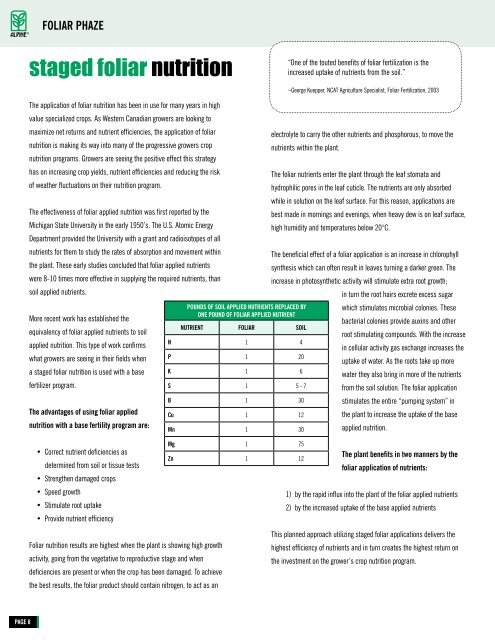view ALPINE'S Efficient Use of Fertilizer - Alpine Plant Foods
view ALPINE'S Efficient Use of Fertilizer - Alpine Plant Foods
view ALPINE'S Efficient Use of Fertilizer - Alpine Plant Foods
Create successful ePaper yourself
Turn your PDF publications into a flip-book with our unique Google optimized e-Paper software.
PAGE 8<br />
foliAr PHAzE<br />
staged foliar nutrition<br />
The application <strong>of</strong> foliar nutrition has been in use for many years in high<br />
value specialized crops. As Western Canadian growers are looking to<br />
maximize net returns and nutrient efficiencies, the application <strong>of</strong> foliar<br />
electrolyte to carry the other nutrients and phosphorous, to move the<br />
nutrition is making its way into many <strong>of</strong> the progressive growers crop<br />
nutrition programs. Growers are seeing the positive effect this strategy<br />
nutrients within the plant.<br />
has on increasing crop yields, nutrient efficiencies and reducing the risk<br />
The foliar nutrients enter the plant through the leaf stomata and<br />
<strong>of</strong> weather fluctuations on their nutrition program.<br />
hydrophilic pores in the leaf cuticle. The nutrients are only absorbed<br />
while in solution on the leaf surface. For this reason, applications are<br />
The effectiveness <strong>of</strong> foliar applied nutrition was first reported by the<br />
best made in mornings and evenings, when heavy dew is on leaf surface,<br />
Michigan State University in the early 1950’s. The U.S. Atomic Energy<br />
Department provided the University with a grant and radioisotopes <strong>of</strong> all<br />
high humidity and temperatures below 20°C.<br />
nutrients for them to study the rates <strong>of</strong> absorption and movement within<br />
The beneficial effect <strong>of</strong> a foliar application is an increase in chlorophyll<br />
the plant. These early studies concluded that foliar applied nutrients<br />
synthesis which can <strong>of</strong>ten result in leaves turning a darker green. The<br />
were 8-10 times more effective in supplying the required nutrients, than<br />
increase in photosynthetic activity will stimulate extra root growth;<br />
soil applied nutrients.<br />
in turn the root hairs excrete excess sugar<br />
PoUnds <strong>of</strong> soil APPliEd nUtriEnts rEPlAcEd by<br />
which stimulates microbial colonies. These<br />
More recent work has established the<br />
equivalency <strong>of</strong> foliar applied nutrients to soil<br />
onE PoUnd <strong>of</strong> foliAr APPliEd nUtriEnt<br />
nUtriEnt foliAr soil<br />
bacterial colonies provide auxins and other<br />
root stimulating compounds. With the increase<br />
applied nutrition. This type <strong>of</strong> work confirms<br />
n 1 4<br />
in cellular activity gas exchange increases the<br />
what growers are seeing in their fields when P 1 20<br />
uptake <strong>of</strong> water. As the roots take up more<br />
a staged foliar nutrition is used with a base k 1 6<br />
water they also bring in more <strong>of</strong> the nutrients<br />
fertilizer program.<br />
s 1 5 - 7<br />
from the soil solution. The foliar application<br />
b 1 30<br />
stimulates the entire “pumping system” in<br />
the advantages <strong>of</strong> using foliar applied<br />
cu 1 12<br />
the plant to increase the uptake <strong>of</strong> the base<br />
nutrition with a base fertility program are:<br />
Mn 1 30<br />
applied nutrition.<br />
• Correct nutrient deficiencies as<br />
determined from soil or tissue tests<br />
• Strengthen damaged crops<br />
• Speed growth<br />
• Stimulate root uptake<br />
• Provide nutrient efficiency<br />
Foliar nutrition results are highest when the plant is showing high growth<br />
activity, going from the vegetative to reproductive stage and when<br />
deficiencies are present or when the crop has been damaged. To achieve<br />
the best results, the foliar product should contain nitrogen, to act as an<br />
Mg 1 75<br />
zn 1 12<br />
“One <strong>of</strong> the touted benefits <strong>of</strong> foliar fertilization is the<br />
increased uptake <strong>of</strong> nutrients from the soil.”<br />
–George Kuepper, NCAT Agriculture Specialist, Foliar Fertilization, 2003<br />
the plant benefits in two manners by the<br />
foliar application <strong>of</strong> nutrients:<br />
1) by the rapid influx into the plant <strong>of</strong> the foliar applied nutrients<br />
2) by the increased uptake <strong>of</strong> the base applied nutrients<br />
This planned approach utilizing staged foliar applications delivers the<br />
highest efficiency <strong>of</strong> nutrients and in turn creates the highest return on<br />
the investment on the grower’s crop nutrition program.


